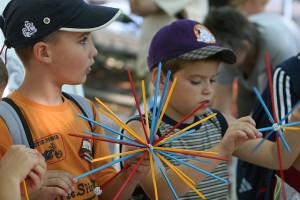

The 2011 Bridges Conference was held at the University of Coimbra, Portugal, during July 27–31, 2011. The City of Coimbra and its river, the Rio Mondego with its four bridges was a beautiful setting for the Bridges Conference!
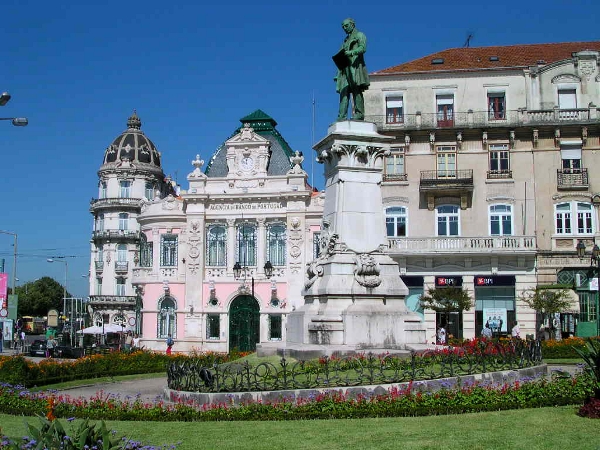
The formal talks and the juried art exhibition of the conference program were complemented by a wide variety of interactive workshops, several evening programs devoted to music and theater performances, movies with a math-art theme, and special day programs of poetry and family math-art activities.
Bridges Coimbra 2011
FAMILY DAY & MATH-ART EXPO
included
THREE SPECIAL PROGRAMS:
Movie Festival, Theater Show, and Poetry Reading
Saturday, 30 July, 2011, Coimbra, Portugal – Europe
ISEC-Instituto Superior de Engenharia de Coimbra
Room 1, Chair: Simon Morgan
2:30-4:00 PM
Workshop Design Thinking Lab: Math Goes Fashion
Konrad Cernohous, Dominik Gross, Petra Ilias, Walter Lunzer, Ruth Mateus-Berr, Jasmin Schaitl, and Peter Michael Schultes
The presenters will offer a cross-disciplinary workshop integrating mathematics, art, design, architecture and especially fashion in the classroom, or a workspace at a university, in a very creative manner. They will incorporate basic mathematical ideas such as triangulation, hyperbolic geometry and the class of convex polyhedrons known as platonic solids. Students and teachers engaged in this project will be immersed in the creative process, and they can join in wherever they are interested. They will create, discuss and prototype their ideas, and explore mathematical tools, integrating them with art and the design process.
4:00-5:30 PM
Alabaster Sculpture Workshops
Nicholas Durnan
 Working, carving and polishing alabaster is a highly creative and rewarding activity. Children of all ages delight in being able to take a small rough piece of stone and within one to two hours have shaped and polished a magical shape. Spheres, ovoids, tori, even mobius bands can be easily made with just a hand drill, hand saw, rasps, rifflers and four grades of wet and dry abrasive paper. Alabaster is a soft and easily available material which can be shaped quickly thus keeping the students’ attention. Patterns and templates in card can be prepared beforehand for marking out onto the alabaster. This workshop will give teachers and artists alike the opportunity to experience the skills required to work with alabaster and discuss the way the artist creates alabaster sculpture using mathematical forms.
Working, carving and polishing alabaster is a highly creative and rewarding activity. Children of all ages delight in being able to take a small rough piece of stone and within one to two hours have shaped and polished a magical shape. Spheres, ovoids, tori, even mobius bands can be easily made with just a hand drill, hand saw, rasps, rifflers and four grades of wet and dry abrasive paper. Alabaster is a soft and easily available material which can be shaped quickly thus keeping the students’ attention. Patterns and templates in card can be prepared beforehand for marking out onto the alabaster. This workshop will give teachers and artists alike the opportunity to experience the skills required to work with alabaster and discuss the way the artist creates alabaster sculpture using mathematical forms.
Maximum number of participants: 15.
5:30-7:00 PM
Build Something Beautiful and Interesting with Giant Triangles: An Entry to Deep Mathematics
Simon Morgan and Jacqueline Sack
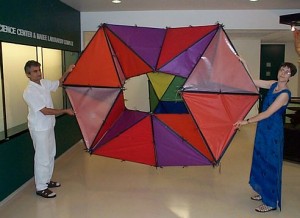 The Giant Triangles are brightly colored lightweight, 1 meter edge length, equilateral triangles, which can quickly be assembled and reassembled into polyhedra. This workshop activity was developed in an urban teacher preparation program for students with little or no prior exposure to conceptual or investigative learning approaches. It involves groups building their own creations with the triangles which are to be ‘beautiful and interesting’ and then explaining why their creation is beautiful and interesting. Taking each creation in turn, we will discuss how to bring out the inherent mathematics and identify key teaching opportunities in whole group discussions.
The Giant Triangles are brightly colored lightweight, 1 meter edge length, equilateral triangles, which can quickly be assembled and reassembled into polyhedra. This workshop activity was developed in an urban teacher preparation program for students with little or no prior exposure to conceptual or investigative learning approaches. It involves groups building their own creations with the triangles which are to be ‘beautiful and interesting’ and then explaining why their creation is beautiful and interesting. Taking each creation in turn, we will discuss how to bring out the inherent mathematics and identify key teaching opportunities in whole group discussions.
Room 2, Chair: Slavik Jablan and Kristóf Fenyvesi
2:30-4:00 PM
Decalcomania
Mary Wahr
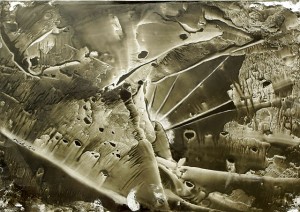 Decalcomania was originally a term that referred to transferring designs from specialty paper to pottery or glass. In artwork, decalcomania means transferring art material from one surface to another. When the surfaces are pulled apart a beautiful fractal pattern results. The process was invented by the Surrealists and has been reinvented by some contemporary artists. This workshop gives an introduction to fractals, a brief overview of the history of decalcomania and the opportunity for participants to create decalcomania.
Decalcomania was originally a term that referred to transferring designs from specialty paper to pottery or glass. In artwork, decalcomania means transferring art material from one surface to another. When the surfaces are pulled apart a beautiful fractal pattern results. The process was invented by the Surrealists and has been reinvented by some contemporary artists. This workshop gives an introduction to fractals, a brief overview of the history of decalcomania and the opportunity for participants to create decalcomania.
Maximum number of participants: 25.
4:00-5:30 PM
Pieces of Pi? Polyhedra, Orthoschemes and Dihedral Kaleidoscopes
Curtis Palmer
Studying polyhedral forms is essential for mathematicians, architects, scientists, biologists, even artists, and for children it can be a lot of creative fun. This workshop will show that dihedral kaleidoscopes are useful tools for teaching mathematical concepts to a range of age groups. Workshop participants will experience creating a paper orthoscheme (also called: simplex, plug, quantum of shape, symmetry unit) and discover that polyhedra can be understood as products of kaleidoscopic reflections and rotations of such a simplex, see Coxeter [3]. The workshop will conclude with the collective creation of a paper polyhedra out of individualized, i.e. decorated simplexes. This transient sculpture will serve as visceral proof of the polyhedral consequences of symmetry operations.
Maximum number of participants: 30.
5:30-7:00 PM
The Vasarely Playhouse: Look and Combine!
Workshop & Bookshow (Check out the newly published Vasarely MathArt album, click here!)
Slavik Jablan and Kristóf Fenyvesi
 Many of Victor Vasarely’s (1906-1997) works are based on the modularity and construction of different visual objects from prefabricated basic elements. In this workshop we would like to illustrate a few of Vasarely’s main visual concepts: the use of transparent elements in sculpture, the recombination of tiles for obtaining different patterns and the use of Op-art effects. For this we propose three constructions: production of a hypercube from a transparent hypercube net, 3D transparent Op-cubes by folding and gluing printed transparent elements, and an Op-tile game. Participants can thus explore the mathematical dimensions of Victor Vasarely’s world and have a memorable glimpse of Jablan and Fenyvesi’s collaboration on the field of experience-centered education of mathematics and the pragmatist aesthetics of interdisciplinarity. This workshop also serves as an introduction of The Vasarely Playhouse math-art album (authors: Slavik Jablan & Ljiljana Radovic; edited by: Kristóf Fenyvesi) which was released just some weeks before the Bridges 2011 by the Vasarely Museum of Pécs city, Hungary!
Many of Victor Vasarely’s (1906-1997) works are based on the modularity and construction of different visual objects from prefabricated basic elements. In this workshop we would like to illustrate a few of Vasarely’s main visual concepts: the use of transparent elements in sculpture, the recombination of tiles for obtaining different patterns and the use of Op-art effects. For this we propose three constructions: production of a hypercube from a transparent hypercube net, 3D transparent Op-cubes by folding and gluing printed transparent elements, and an Op-tile game. Participants can thus explore the mathematical dimensions of Victor Vasarely’s world and have a memorable glimpse of Jablan and Fenyvesi’s collaboration on the field of experience-centered education of mathematics and the pragmatist aesthetics of interdisciplinarity. This workshop also serves as an introduction of The Vasarely Playhouse math-art album (authors: Slavik Jablan & Ljiljana Radovic; edited by: Kristóf Fenyvesi) which was released just some weeks before the Bridges 2011 by the Vasarely Museum of Pécs city, Hungary!
Maximum number of participants: 25.
DOWNLOAD THE WORKSHOP-MATERIAL HERE!
(CLICK, 35 Mbyte, ZIP file)
Room 3, Chair: Sarah Abdellahi
2:30-4:00 PM
Human Geometry Workshop
Mike Naylor and Vi Hart
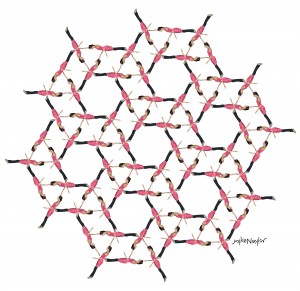 What kind of geometry can we make with our bodies? In this 90-minute workshop we’ll explore all kinds of fun ways to use our hands, arms, legs, and bodies to create fantastic shapes with ourselves and with a group. Frieze patterns, polygons, polyhedra, connected graphs, fractals and tessellations are a few of the exciting shapes we’ll create. We’ll present ideas, challenges, games, and problems to solve that will make you physically a part of mathematics! These ideas can be used in the math classroom to teach concepts and generate excitement for mathematics.
What kind of geometry can we make with our bodies? In this 90-minute workshop we’ll explore all kinds of fun ways to use our hands, arms, legs, and bodies to create fantastic shapes with ourselves and with a group. Frieze patterns, polygons, polyhedra, connected graphs, fractals and tessellations are a few of the exciting shapes we’ll create. We’ll present ideas, challenges, games, and problems to solve that will make you physically a part of mathematics! These ideas can be used in the math classroom to teach concepts and generate excitement for mathematics.
Be prepared to get creative and bring home some great photographs!
4:00-5:30 PM
A Workshop on Stellation Inspired Sculpture
Eve Torrence
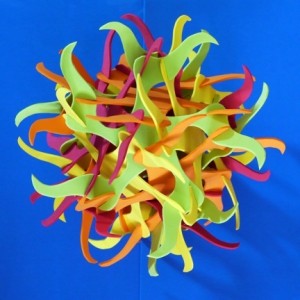 In this workshop we will study the structure of some of the complex and beautiful sculptures by George Hart. Knowledge of the geometric concept of stellation is fundamental to understanding how these sculptures are designed and constructed. We will learn how stellation is used to produce complex polyhedra. The author has designed a simple puzzle sculpture kit based on this concept. Each participant will assemble one of these kits. Constructing and studying this small sculpture will enhance the understanding and appreciation of George Hart’s creations.
In this workshop we will study the structure of some of the complex and beautiful sculptures by George Hart. Knowledge of the geometric concept of stellation is fundamental to understanding how these sculptures are designed and constructed. We will learn how stellation is used to produce complex polyhedra. The author has designed a simple puzzle sculpture kit based on this concept. Each participant will assemble one of these kits. Constructing and studying this small sculpture will enhance the understanding and appreciation of George Hart’s creations.
5:30-7:00 PM
The Geometry of Paradise Flowers
Sarah Abdellahi and Tom Goris
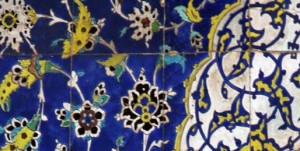 When thinking about Islamic mosaics, it might seem that only mosaics that have geometrical patterns involve mathematics, however, there is an interesting amount of mathematics in floral designs too: each flower individually and all of the various connections between the flowers are based on circular patterns. In this workshop the participants will learn about these constructions step by step. Next, they will design a flower themselves, based on the fixed base shapes of the mosaics but leaving enough degrees of freedom to be creative. The newly designed flowers will be attached to a prefabricated framework to make a wonderful collaborative design.
When thinking about Islamic mosaics, it might seem that only mosaics that have geometrical patterns involve mathematics, however, there is an interesting amount of mathematics in floral designs too: each flower individually and all of the various connections between the flowers are based on circular patterns. In this workshop the participants will learn about these constructions step by step. Next, they will design a flower themselves, based on the fixed base shapes of the mosaics but leaving enough degrees of freedom to be creative. The newly designed flowers will be attached to a prefabricated framework to make a wonderful collaborative design.
Maximum number of participants: 28.
Room 4
Sessions start at 2:30 PM, 4:00 PM, 5:30 PM
CLAYMETRY
Jouko Koskinen
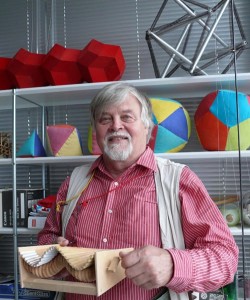
The main aim is to let attendants to do, experience and feel by and in their hands some basic 3D laws of Nature. We will use soft clay instead of soap bubbles to produce durable minimal/optimal shapes.
Maximum number of participants: 20 persons / session.
Venue 5
2:30-7:00 PM
Pythagorean Paper Quilt
Elaine Krayenke Ellison
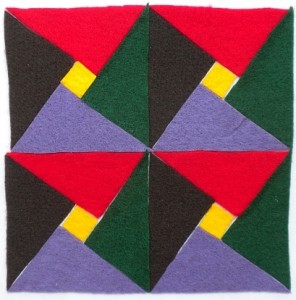
We will use the Pythagorean theorem as a starting point. Bhaskara’s (1114-1185) proof of the theorem will be illustrated and explained. The participant will then cut the 4 triangles plus one square. Either sticky backed felt or paper will be used to complete the pattern. Now a2+b2=c2 appears as a pleasant and fascinating pattern.
Venue 6
5:00-7:00 PM
Mathematical Magic
Fernando Blasco Sr., Gema Uceda, Fernando Blasco Jr.
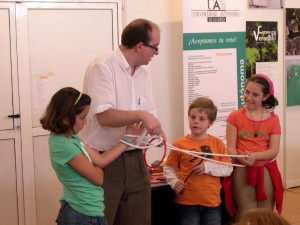
In this workshop we teach some mathematical magic tricks. Although magic tricks usually remain as a secret, the mathematical patterns in some of them and the ideas underlying are even more interesting that the trick itself. Children enjoy the magic and adults will like the explanations.
Venue 7
Sessions start at 2:30 PM, 3:30 PM, 4:30 PM, 5.30 PM, 6:30 PM
Pentapuzzles
Jean-Marc Castera
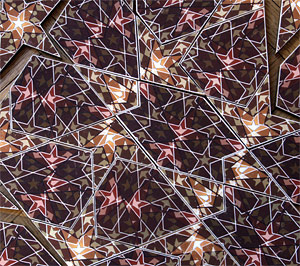
Playing with different sets of tiles related to the pentagonal family of traditional geometric patterns, and to contemporary mathematics as well.
Maximum number of participants: 7 persons / session.
Venue 8
2:30-7.00 PM
Zometool Workshop
Paul Hildebrandt

Venue 9
Sessions start at 4:00 PM, 5.30 PM
Origami & Mathematics
Wojtek Burczyk
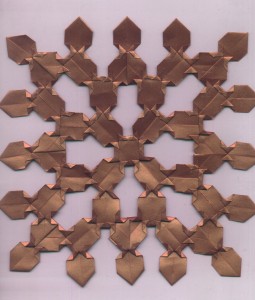
We will make simple fractal origami models (Pithagoras tree) and origami mosaics. Our models are easy to make for children, but we have something interesting for adults as well.
2:30-3:45 PM: ISEC Main Auditorium: Festival of Short Mathematical Movies: The 2nd Annual Bridges Short Movie Festival was emceed by Amy and Nathan Selikoff (archristie@gmail.com; nselikoff@gmail.com). The program included a variety of juried and curated videos and animations that have been created for educational, corporate, or artistic purposes. It provided yet another opportunity for you to experience innovative and integrative techniques in the fields of mathematics and art. We enjoyed a virtual reenactment of Escher’s Drawing Hands, a visual representation of the movement of energy in the universe, and a demonstration of the bubble sort algorithm via Hungarian folk dance, plus many more amazing works.
4:00-5:15 PM: ISEC Main Auditorium: Theater: Staged Reading of “The Physicists”: The first Bridges Theater Night was held in 2009. The model for that evening was a program of short scenes selected from a wide array of contemporary mathematical plays by Tom Stoppard, Snoo Wilson, and Theatre Complicite, among others. In 2010, the Dr. Schaffer and Mr. Stern Dance Ensemble performed a mathematically inspired piece entitled “The Secret Life of Squares.” In 2011 the focus returned to dramatic theater with The Physicists, by Friedrich Dürrenmatt – in the form of a staged reading. As in the past, the cast was formed from conference participants by Steve Abbott (abbott@middlebury.edu), the curator of the special event.
5:30-7:00 PM: ISEC Main Auditorium: Reading of Mathematical Poetry: For all of you poetry lovers, Bridges Coimbra had a new special event to offer: “Poetry Day,” which was coordinated by University of Connecticut mathematician and poet, Sarah Glaz, and featured a reading of poetry with strong links to mathematics. The program included poets Emily Grosholz, JoAnne Growney, Amy Uyematsu, and Sarah Glaz reading from their own poems; a bilingual Portuguese-English reading of poems translated by Coimbra mathematician and translator Fracisco Craveiro; and contemporary Iranian poetry in translation read by Saeed Ghahramani. For more details see the Bridges Poetry Day program: http://bridgesmathart.org/bridges-2011/2011-poetry-day/
9:30-11:00 PM: ISEC Main Auditorium: Informal Music Night: After the conclusion of the programs, everybody was invited back to the ISEC main auditorium for an Informal Music Night (see: http://bridgesmathart.org/bridges-2011/2011-music-night/).

